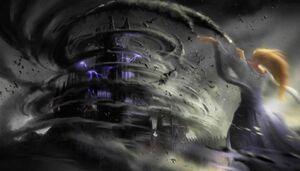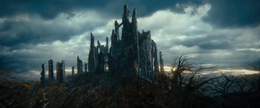Dol Guldur, also known as the Hill of Dark Sorcery, was Sauron's stronghold and base of operations when he worked his sorcery in the wood under the name of The Necromancer. It was located in the south of Mirkwood for over twelve-hundred years in the Third Age.
History
Construction
Dol Guldur was established by Sauron after his return to Middle-earth sometime after TA 1000. Sauron became known as the Necromancer, and his identity was long kept secret. Dol Guldur was built on the hill known as Amon Lanc (meaning "bald hill"), and had been the capital of Oropher's Silvan realm. The Silvan Elves had fled north to the Black Mountains (later the Mountains of Mirkwood) after Sauron's return from the Downfall of Númenor. Later, after Sauron captured Amon Lanc, Thranduil, son of Oropher, led his people over the Forest River, where they remained. Sauron later remained there for hundreds of years.
The Fortress of the Necromancer

The Necromancer as seen in the first Hobbit film
The White Council long feared the power in Dol Guldur might be Sauron, but Saruman opposed assaulting it. However, Gandalf later went to Dol Guldur himself and discovered that the Necromancer was indeed Sauron. He then informed the White Council, and Saruman was unable to protest. The White Council attacked Dol Guldur, and Sauron, not yet powerful enough to challenge them, fled to Mordor.
Sauron continued to increase his power over the next 100 years and search for the Ring.
In TA 2845, Thráin II, holder of the last of the Seven Rings of the Dwarves, was imprisoned in Dol Guldur's dungeons. In TA 2850, Gandalf again entered Dol Guldur, and found the dying Thráin. Gandalf was entrusted with the map and key to give to Thorin Oakenshield, Thráin's son, although Thráin could not tell Gandalf his own name or the name of his son before he died. Gandalf confirmed Sauron was the master of Dol Guldur at that time.
Gandalf returned to the White Council and urged an attack on Dol Guldur, but was overruled by Saruman. In TA 2941, Saruman finally agreed to an attack, which occurred at the same time as the Quest for Erebor. This was carefully planned by Gandalf, so that Sauron and Smaug could not assist each other, as otherwise they surely would have done. The White Council attacked Dol Guldur, and drove out Sauron. Sauron fled to Mordor, his plans nearly ready. In TA 2951, Sauron declared himself openly and sent three Nazgûl led by Khamûl to reoccupy Dol Guldur.
Destruction

Galadriel's destruction of Dol Guldur, as seen in BFME2
During the War of the Ring, the forces of Dol Guldur were led by Khamûl, the Ringwraith second in command to the Witch-King of Angmar. He and his armies made three assaults upon Lórien and Thranduil's realm in Mirkwood, causing grievous damage to the outlying woodlands, but they were driven back each time by the power of Nenya, Galadriel's Ring of Power, which only Sauron himself could have overcome. The elves, led by Thranduil of Mirkwood and Galadriel of Lórien led an assault on Dol Guldur and Galadriel herself threw down its walls, and laid its pits bare. Absolutely nothing of the fortress that had stood for 2,019 years was left. Renamed back to Amon Lanc, it became the capital of Celeborn's realm of East Lórien in the Fourth Age, while he remained in Middle-earth.[2][3][4]
Etymology
Dol Guldur was a Sindarin word that means "Hill of Dark Sorcery", from dol ("hill") and guldur ("dark sorcery"). It was previously known as Amon Lanc, the "Bald Hill", from amon ("hill") and lanc ("bald").[5]
Portrayal in adaptations
The Hobbit film trilogy

Dol Guldur is briefly seen in Peter Jackson's The Hobbit: An Unexpected Journey, depicted as a huge, decaying castle set on top of a hill. In a scene unique to the film, Radagast the Brown enters the fortress to investigate the evil force within. He briefly battles the Witch-king of Angmar (or his summoned shade) before seeing the Necromancer, and flees to tell Gandalf what he saw.
In the The Hobbit: The Desolation of Smaug, after leaving Bilbo and the party of Dwarves to make their own way through Mirkwood, Gandalf seeks the tombs of nine servants of Sauron in the High Fells of Rhudaur who were the bearers of the nine rings of power given to men. The tombs of the Nine Ringwraiths were opened showing their summoning from the dead. After this discovery Gandalf convenes with Radagast in the High Fells, both he and Radagast then travel to Dol Guldur to investigate further and confront the evil which dwelt there. Gandalf performs revealing spells that remove the illusion displaying the castle as abandoned and ruined. In the extended edition, Gandalf finds Thrain there and helps him to escape. Gandalf and Thrain are then attacked by Azog who reveals his hordes of Orcs and Wargs inside the castle preparing for war. Gandalf uses his magic to escape Azog, but the Necromancer manifests at Dol Guldur's exit. The Necromancer sucks Thrain in and kills him. The two then start a battle of light and shadow until The Necromancer defeats Gandalf, destroys his staff, and then reveals himself as the Dark Lord Sauron. Gandalf is later seen trapped in one of the cages of the castle watching the vast hordes of Sauron's armies leaving Dol Guldur.

Galadriel and Gandalf in Dol Guldur, surrounded by The Nine
In the The Hobbit: The Battle of the Five Armies, Galadriel, Elrond and Saruman are seen gathering at Dol Guldur to face Sauron and all of the nine Ringwraiths.
Galadriel keeps her promise made to Gandalf in the first Hobbit film, and goes to his aid in Dol Guldur. She interrupts an orc who is just about to kill Gandalf, using her magic to blast him away. She then carries the unconscious Gandalf to safety, but as she does Sauron summons the Nazgul. Galadriel is horrified by the sight of them, and Sauron taunts her for being alone, but Galadriel replies she is not alone.
Elrond arrives on the scene and draws his sword. Saruman, appearing shortly after Elrond, witnesses the Nazgul with his own eyes, realizing he was wrong to doubt Gandalf's claims. Elrond strikes first and defeats a few of them, and Saruman enters the fray. While the two of them are locked in a fierce battle with the Nazgul, Galadriel heals Gandalf with a kiss. When he comes to, he and Galadriel acknowledge that Sauron has returned. Radagast then arrives in Dol Guldur to take Gandalf to safety, but he is hesitant to leave Galadriel's side. Galadriel suddenly enters a trance and forcefully commands Radagast to take Gandalf away.
When Sauron manifests before them, Saruman quickly uses his power to control Galadriel and she takes on a terrifying and corrupted image and challenges him. Sauron attempts to sway her to his side, but she denies him. While the two battle each other in minds and words, Galadriel's power overrules Sauron. Eventually by her efforts Sauron is banished from Dol Guldur, with his spirit fleeing from the wrath of the Elf Queen. Elrond escorts Galadriel to safety after her struggle with Sauron on orders from Saruman while he deals with Sauron.
Video games
- In Battle for Middle-earth II, Dol Guldur was commanded by the Mouth of Sauron, not Khamûl the Ringwraith. Dol Guldur (or Mordor itself) sent a huge army of Orcs, Haradrim, and Trolls to assault the Lonely Mountain and greatest Kingdom of the Dwarves. The attack fails, and the Mouth of Sauron is killed along with all the attacking force. Dol Guldur is then itself attacked by a combined army of Elves and Dwarves led by Elrond, Arwen, Glorfindel, Gloin, Thranduil and Dain Ironfoot. After a long and hard struggle, the Elves and Dwarves finally overrun Dol Guldur and lay waste to the evil that dwelt there, ending Sauron's war campaign in the North once and for all (unless Sauron had seized the Ring, which never happened).
In this game, Dol Guldur has numerous turrets and can summon dark creatures to their aid, creatures that were probably unlikely to appear in the battle according to Tolkien's mythology. The Watcher in the Water appears numerous times, and the Goblin/Isengard dragon occasionally appears. The Balrog itself is also summoned as a final obstacle. It is assumed that they were added to intensify the level.
It is presumed that, following the destruction of Dol Guldur, it would have been returned to its former state as Amon Lanc and taken as East Lorien, just like it had happened in the story line.
Toys
LEGO created three Dol Guldur kits, called "Dol Guldur Ambush", "Dol Guldur Battle" and "Witch-king Battle".
"Dol Guldur Ambush" is a small kit that comes with two Gundabad orc mini-figures and a Beorn mini-figure.A hide-away axe can pulled up to chop up the mini-figure standing there. It also includes a catapult.
"Dol Guldur Battle" is a larger kit that includes two Gundabad orcs, Azog, The Necromancer, Radagast and Gandalf mini-figures. Radagast is exclusive to this kit. At the front gate a vine can be pulled, which makes a LEGO skull drop down on the mini-figure below. In the middle The Necromancer has a secret spin-wall which can turn to reveal the Necromancer if a torch is turned. The top of a tower can do multiple things. One, a catapult can be attached to the top, so it can shoot the brick farther. Second, the catapult can be taken off and a large rock with a stick poking out can be attached. Hanging on the stick is a chain which holds a dangling prison cage, like the one Gandalf was captured in. A small pin can be pulled out, making the cage violently fall down and hit against the tower wall.
"Witch-king Battle" features a small fortress with a catapult and a spinning wheel. The spinning wheel allow players to spin the minifigure to have extra battle force. Galadriel, Elrond and Witch-king, in a total of three minifigures, are given in this set. Galadriel, Witch-king and the variation of Elrond are exclusive to this set.
Translations around the World
| Foreign Language | Translated name |
|---|---|
| Chinese (Hong Kong) | 多爾哥多 |
Gallery
|
Places of Middle-earth and Arda
Middle-earth Locations:
Provinces/Regions: Arnor | Dunland | Ettenmoors | Forochel | Forodwaith | Gondor | Harad | Ithilien | Khand | Lindon | Minhiriath | Mordor | Rhovanion | Rhûn | Rivendell | Rohan | The Shire Forests & Mountains: Amon Dîn | Amon Hen | Amon Lhaw | Caradhras | Emyn Muil | Erebor | Fangorn Forest | High Pass | Iron Hills | Lórien | Mirkwood | Mount Doom | Mount Gundabad | Old Forest | Orod-na-Thôn | Tower Hills | Weathertop Hill City/Fortifications: Angband | Barad-dûr | Bree | Caras Galadhon | Dol Guldur | Fornost Erain | Hornburg | Isengard | Minas Morgul | Minas Tirith | Last Homely House | Tower of Amon Sûl | Tower of Orthanc | Osgiliath | Umbar | Utumno Miscellaneous: Argonath | Astulat | Buckland | Cair Andros | Dagorlad | Dead Marshes | Enedwaith | Fords of Isen | Gap of Rohan | Grey Havens The rest of Arda:
Aman | Burnt Land of the Sun | Dark Land | Empty Lands | Neldoreth | New lands | Númenor | Tol Eressëa |
References
- ↑ The Lord of the Rings, Appendix B: The Tale of Years (Chronology of the Westlands), "The Great Years"
- ↑ The Atlas of Middle-earth, Regional Maps, "Eriador"
- ↑ The Atlas of Middle-earth, Regional Maps, "The Misty Mountains"
- ↑ The Atlas of Middle-earth, The Lord of the Rings, "Battles in the North"
- ↑ Parma Eldalamberon, Words, Phrases and Passages in Various Tongues in The Lord of the Rings by J.R.R. Tolkien




